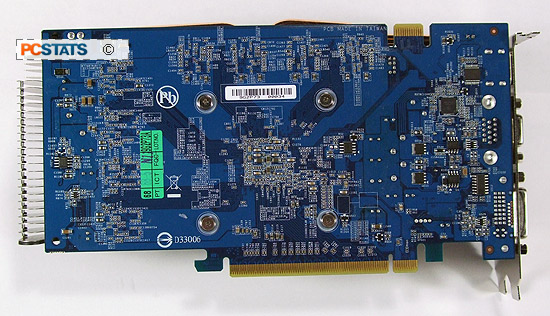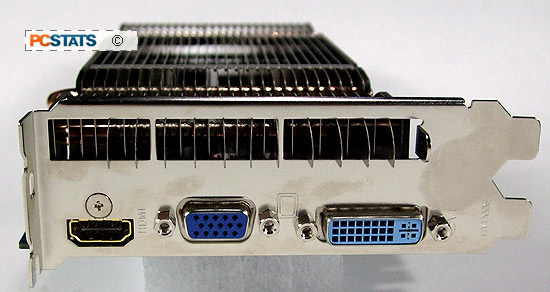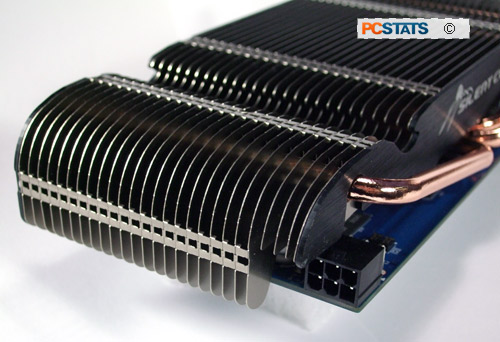
|
This isn't an old 9600GT GPU making a comeback with 1GB of GDDR3 memory, this new Geforce 9600GT graphics card from Gigabyte uses the 'revision B' nVidia 'G94' GPU; it's built with a smaller manufacturing process, has a physically smaller silicon die, uses less power and consequently runs cooler.
85% Rating: 
|
|
|
|
Home >
Reviews >
Video Cards >
Gigabyte GV-N96TSL-1GI |
|
|
It's easy to mistake the Gigabyte GV-N96TSL-1GI videocard
for one of the many Geforce
9600GT's
that have been on the market for over a year... after
all, one Geforce 9600GT is the same as the next, right? Wrong!
This isn't an old 9600GT GPU making a comeback with
1GB of GDDR3 memory, this new Geforce 9600GT graphics card from Gigabyte
uses the 'revision B' nVidia 'G94' GPU; it's built with a smaller manufacturing
process, has a physically smaller silicon die, uses less power and consequently
runs cooler. Reduced power consumption made it possible for Gigabyte engineers
to make the GV-N96TSL-1GI Geforce 9600GT videocard completely fanless. The great
thing about passively cooled videocards are that they're excellent for media
center's, particularly HTPC's that sit next to the television. The last thing
you want to hear while watching a movie is the whine of a VGA cooling fan after
all.
In place of
the stock single-slot videocard thermal solution, Gigabyte's GV-N96TSL-1GI videocard features a
double-slot wide passive "Silent Cell" heatsink with widely spaced fins to take
advantage of convective cooling forces. Three heatpipes help conduct the heat
from the GPU towards the outer reaches of the thin aluminum fins, so even with
the slightest of breezes the videocard runs mildly warm. The heatsink busts out
the back of the PC via a small vent so it also take advantage of the
internal airflow escaping the PC to exhaust heat outside the chassis,
rather than let it just rise and heat up the CPU heatsink.
The changes
don't stop there. The revision 'B' nVidia
'G94' GPU has also been
tweaked while undergoing a die shrink from 65nm to a 55nm, dropping the overall
power use of the videocard. PCSTATS will be testing how much the Gigabyte GV-N96TSL-1GI
has managed to cut its power requirements compared to standard Geforce 9600GTs a
little later in this review.
 |
|
Gigabyte
GV-N96TSL-1GI Videocard |
|
|


| |
Gigabyte's GV-N96TSL-1GI videocard doubles the
previous standard of 512MB video memory found on 1st generation Geforce 9600GTs up
to 1GB of GDDR3. This PCI Express x16 2.0 videocard also supports
nVidia SLI, so two Geforce 9600GTs can be teamed together for a performance advantage.
The card is fully HDCP
compliant and features a dedicated HDMI port for 1080p HD content (it can
carry audio via a SP/DIF pass-through cable into the card). Alongside
the HDMI jack there are Analog and DVI video outputs that support a maximum
resolution of 2560x1600 pixels.

Since the nVidia G94 GPU is
based on familiar technologies, we'll just mention that continues to
be DirectX10, Shader Model 4.0 and HDCP compliant. Additionally, the core
accomodates OpenGL 2.1, 128-bit HDR, nVidia Quantum Effects physics processing,
and Microsoft Windows XP/Vista operating systems. It also supports Purevideo HD
2/VP2 to accelerate High Definition content and reduce CPU load.
Gigabyte has definitely bought some freshness to the
table with the GV-N96TSL-1GI videocard, especially for HTPC owners. A completely
silent video card that's built with a more efficient GPU that has a pedigree of solid gaming
performance, and HDMI.  The Gigabyte GV-N96TSL-1GI videocard should retail for around $150 CDN ($110 USD, £80GBP)
, which puts it at exactly the price of the
old Geforce 9600GT. The Gigabyte GV-N96TSL-1GI videocard should retail for around $150 CDN ($110 USD, £80GBP)
, which puts it at exactly the price of the
old Geforce 9600GT.
Let's take a closer look and see how
this puppy handles!
Home Theatre Ready?
At the business end of the Gigabyte GV-N96TSL-1GI
videocard you'll find the option most important to any serious home theatre PC
builder, the HDMI output.
Unlike AMD Radeon
videocards, the Geforce 9000-series of videocards does not have a built-in audio
codec. You'll need to connect the supplied SP/DIF jumper to the motherboard or soundcard
SP/DIF header if you wish to include the audio stream with
the HDMI output. DVI and VGA video connectors adapters are
handy for users with older CRT monitors still. Dual monitor output is supported with
one monitor being fed signals via DVI and the other through
VGA or HDMI.
On the rear of the Gigabyte GV-N96TSL-1GI videocard
there's an auxiliary 6-pin PCI-Express power socket that needs to be
plugged in. The passive heatsink makes this a bit of tight fit, but it
doesn't block it. The heatsink pushes the width of the GV-N96TSL-1GI videocard
to two slots, and since this is a passively cooled
videocard PCSTATS recommends leaving one additional free slot empty between the GV-N96TSL-1GI videocard and
any other expansion card.
Next up a quick look at the passive videocard heatsink on this Geforce
9600GT videocard from Gigabyte....
|

